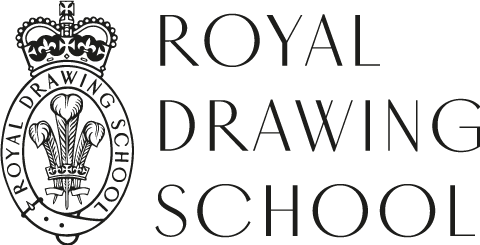Irene Montemurro: The Denis Mahon Award 2020
Irene Montemurro is the recipient of the Denis Mahon Award 2020. Presented to one outgoing Drawing Year student annually, the award allows them to continue their practice, providing them with funding for a studio space as well as a solo exhibition at the end of the year.
Irene’s exhibition was due to open in late April 2020 but with the coronavirus pandemic preventing any physical exhibition in the School’s gallery, she decided to move the exhibition online. Although not what Irene had originally been working towards, a purely digital show offered the opportunity of sharing her work with a whole new audience; ‘So many exhibitions happen primarily online now’ she says, ‘and it means that they can be safe and accessible for a far greater number of people worldwide.’
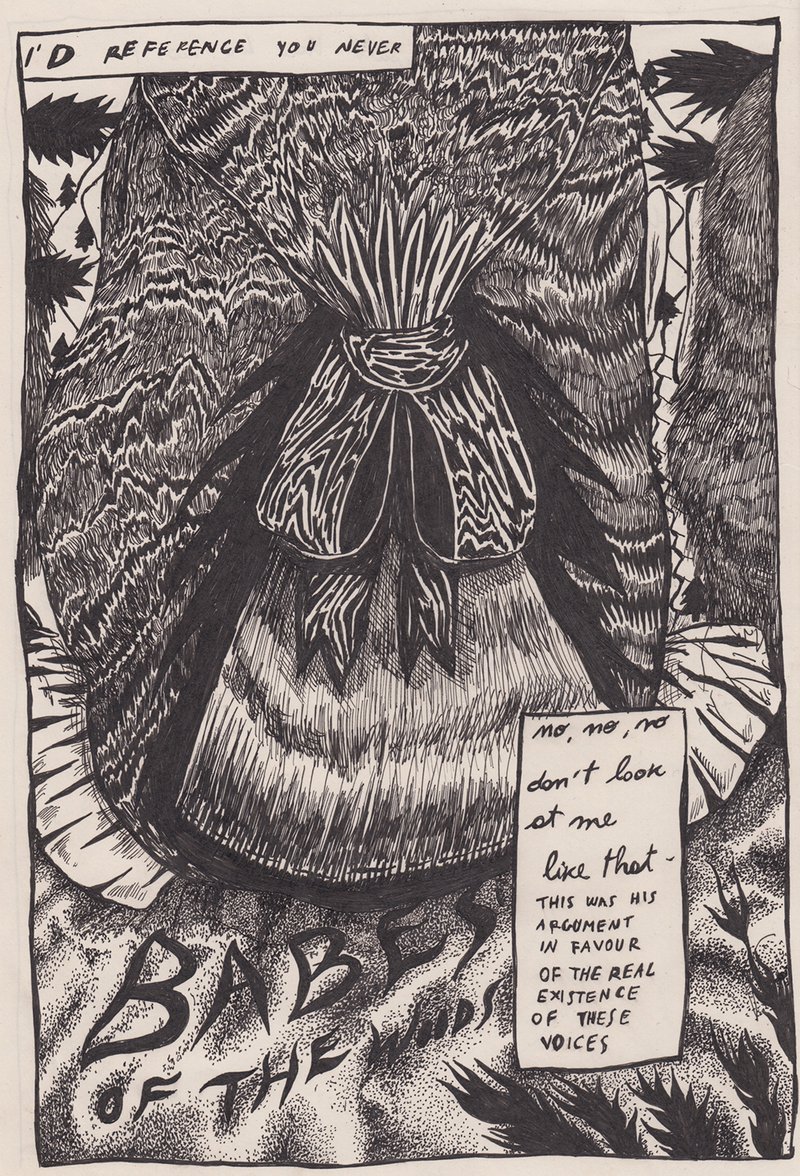
Babes of the Woods (2020)
Gel ink on sketchbook paper, 25 x 18 cm
A Swimming Pool For When We Run Out Of Water is an improvised bedroom exhibition: it will not take place anywhere else in the real world. The exhibition consists of 13 drawings, all made between February and April 2020, as the pandemic took hold in the U.K. and around the world. These were the only works available to be exhibited, all others remained inaccessible at Irene’s studio. ‘Of everything produced over the year’, she says, ‘this is the body of work that feels most relevant right now.’ Not because the works refer directly to the pandemic in any literal way, ‘it’s just a matter of feeling’, she says, ‘in a very personal way’. Indeed, these works are deeply rooted in imagination; ‘If anything, going forward I would like to make work that is even more fantastical. The need to manifest the things that we would like to see feels more urgent than ever.’
Irene’s work deals with subjects including intimacy, personal narrative and storytelling, all of which we encounter with an underlying sense of uneasiness; her work might seem diaristic at first glance, but it is full of surreal fantasy and uncanny juxtaposition that leaves the viewer uncertain about their encounter. ‘Everything I have made’ she says, ‘is both completely fictional and a way of processing my own experiences.’

Sweet Spot/ Il brufolo (2019)
Colour pencil on sketchbook paper, 21 x 30 cm
Irene studied Illustration at Camberwell (UAL) before joining the School’s postgraduate-level programme, The Drawing Year, in 2017. ‘I wanted to apply, she says, ‘because at the time I didn’t feel like I had had the time to explore and create my own imagery. I had mostly been responding to briefs which didn’t leave me the time to develop my own visual vocabulary - I wanted to explore and play with the aesthetics of my practice. Essentially I felt that I needed to learn how to draw.’
‘I expected it to be a year where I would come out with a distinct style, I would ‘find myself’ as an artist but, obviously, that’s not how the course works - it opens up possibilities in your practice rather than closing them down.’ One of the most important things that The Drawing Year gave her, she says, is the ability to draw from her imagination; ‘Through drawing from observation I have found a way to unlock an imaginative way of working. I couldn’t always do that.’
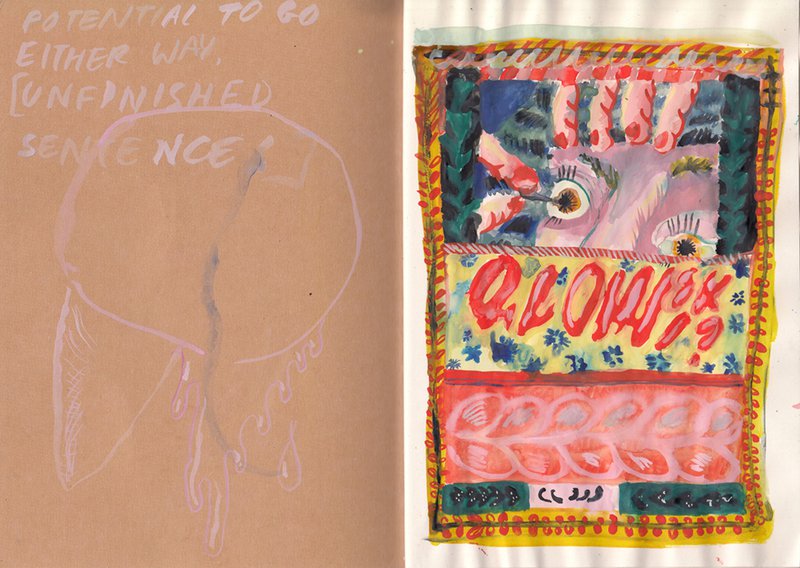
Sketchbook page (2020)
Gouache on paper 14.4 x 20 cm
After eighteen months of exploration and discovery on The Drawing Year, Irene has used the past year and the support of The Denis Mahon Award, to continue to investigate the different pathways that have appeared in her practice since graduating from the course, ‘I now have a few different series of works which are all separate, but speak to each other in some way. It has in a way been like The Drawing Year part two, but focussed solely on my studio practice.’
Throughout the year, Irene had the support of Royal Drawing School tutor, Sarah Pickstone, ‘Having Sarah as my tutor has been great, she’s been very encouraging. This year was the first time I’ve been out of education so to have her advice and guidance has been really valuable. She has been a sounding board, someone to work things through with and someone to react to. She has also been very practical which is something that I have needed.’
The Denis Mahon Award has provided the opportunity for Irene to work in a different way, using the year as a testing ground for areas of her practice she had yet to fully explore: ‘Large scale works and projections, all need a big space but also an audience to work’ she says, and crucially, the year has pushed her to work towards a public exhibition. ‘I am now much more mindful of how something might be exhibited, whereas before I was making work that felt like it was just for me.’ This development in her way of working is seen in the pieces that will be exhibited online - no longer working only from small, closed, private sketchbooks, she has worked on a bigger scale, on flat sheets - these new works are made with an audience in mind.
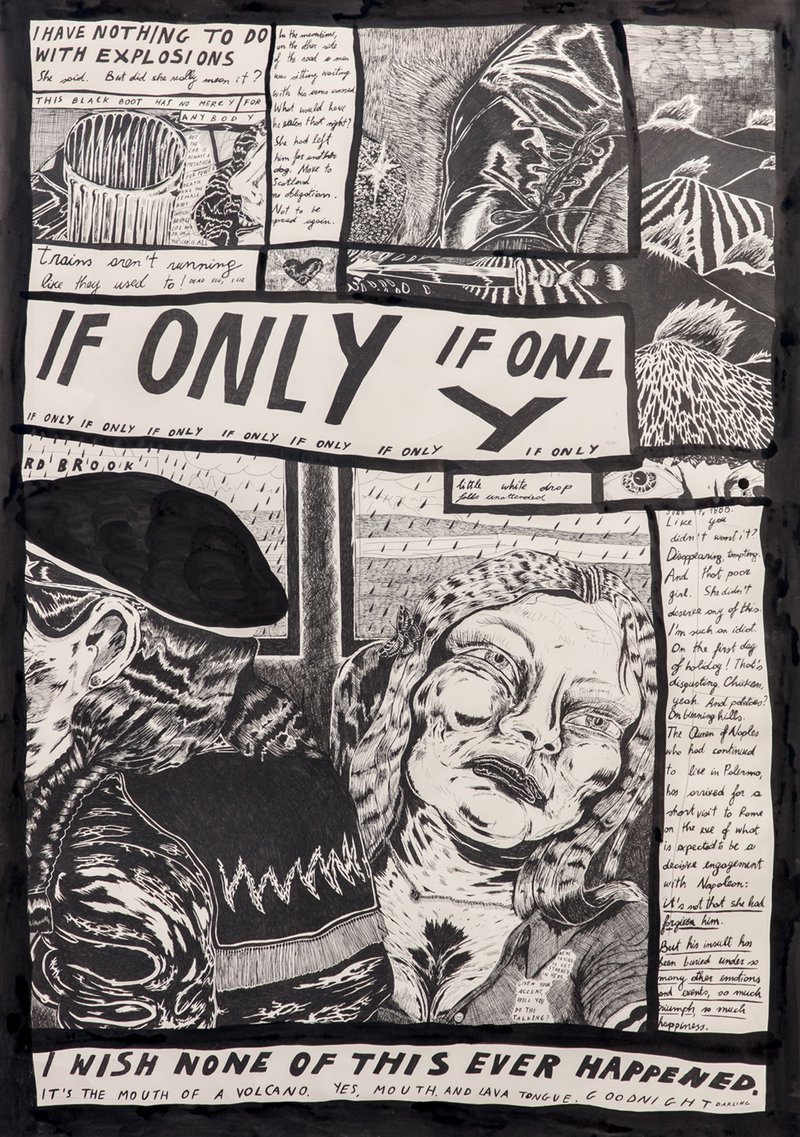
The moths are louder at night (2019)
Gel ink on cartridge paper 59.4 x 84.1 cm
The black and white diary-like works made in sketchbooks that Irene showed at The Drawing Year End of Year Exhibition 2018 have developed; ‘They are more imaginatively collaged and responding to other sources, other influences - from things I’ve been reading, things I’ve watched, music I’ve been listening to. This way of working means that now I am creating images that surprise me as well. I have loosened my control.’
The use of text has also become an important tool in her practice; ‘I tend to open books and find things that speak to me, that inspire me. For me, the text is just as much about what it says, as its pictorial quality, the typography of it and the way it looks on the page. I often use text as an ice-breaker; I might open a book, find lines that work together or seem to speak to each other. The drawing becomes a response to it, a conversation.’
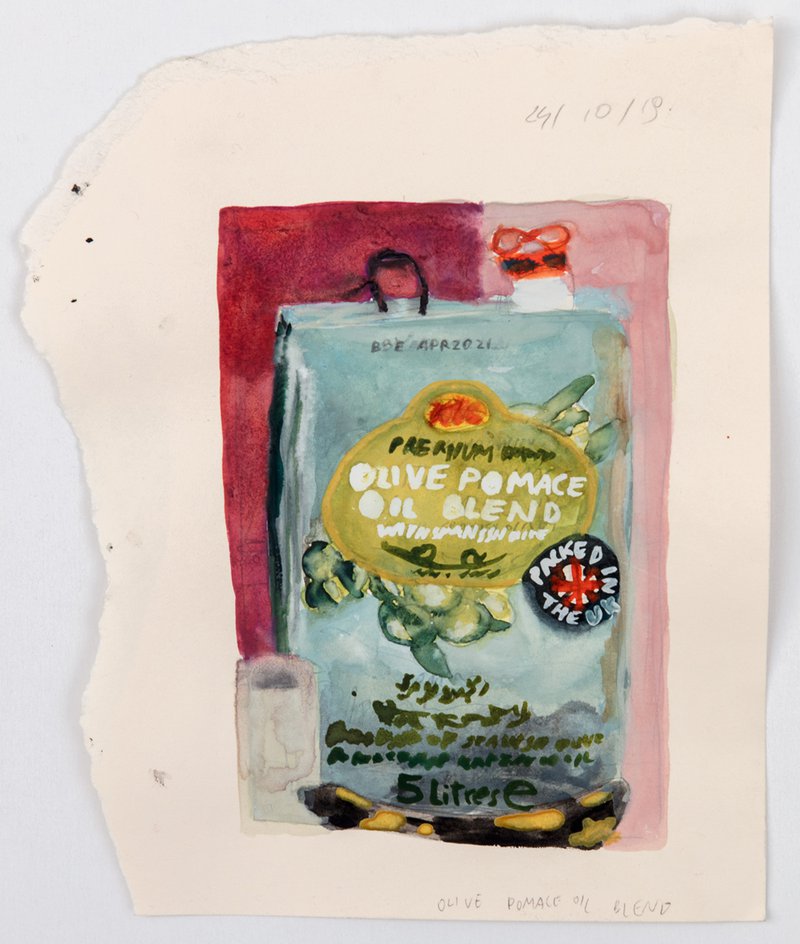
Premium quality olive pomace oil blend with spanish olives (2019)
Gouache and watercolour on cartridge paper 15 x 18 cm
Although she has always worked in colour in the studio, this year felt like an opportunity to engage with it in a more direct way. ‘I find it easier to paint, to use colour, when I’m working from a drawing that I’ve already done in black and white’, she says, ‘because it leaves me space to concentrate on colour itself and not think about the subject. The opposite is true when I’m working in monochrome; I like to focus completely on the subject matter.’
Irene now has various parts of her practice that are at different stages of development. Whilst the monochrome works exhibited in A Swimming Pool For When We Run Out of Water are more realised, she says she thinks ‘the small gouache paintings are still in their infancy and at some point they will catch up. I feel like they’ve been an important strand of this year’s work.’
Irene’s work largely falls into two sizes – very small, or very big: ‘Both’ she says ‘encourage the viewer to be close, I think. The idea of intimacy, how we relate to people quite literally constitutes our experience of day to day life - it’s what we do, who we are. It is what I have appreciated in other works of art, music and literature - their ability to make you feel that you are close to something, someone, that it is really talking to you and is there for you.’
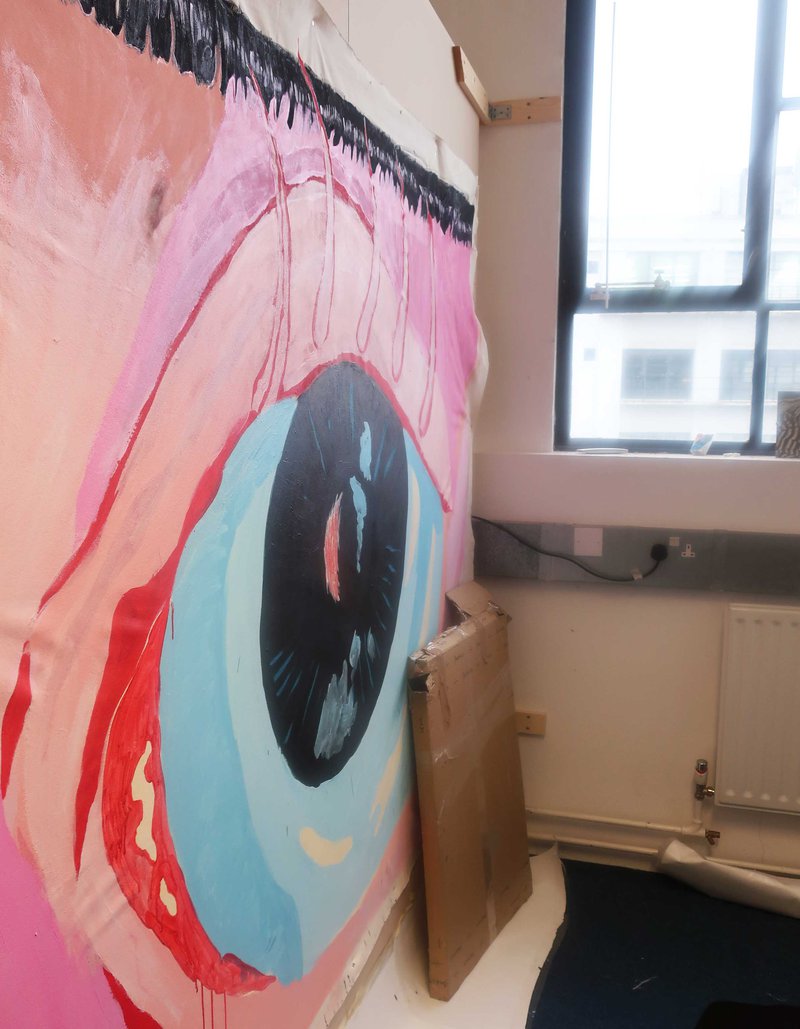
Unfinished piece (2020), Irene's studio
In Irene’s original concept for her physical exhibition, on entering the audience would have been met a large mural of a pair of eyes: ‘I liked the idea of having this exchange with the viewer and the mural played with that idea - who is looking at who? It’s funny really - in one way I am letting them in on my life which is quite vulnerable-making for me, but on the other, these huge eyes greet people as they come in and it’s like a welcome, but also a warning I think.’
This sense of voyeuristic exchange is very present in the online exhibition too, now taking place in her bedroom; ‘I am interested in ways of using drawings to alter or create spaces and tell stories, so this project is a natural progression of that. The website feels like a surreal, slightly unnerving and yet intimate space, where these fictionally confessional drawings live and belong.’
‘The title and ‘decor’ of the exhibition are based on a rough installation concept that I had to repurpose; a dream I had about a swimming pool inside a bedroom, some staged Cecil Beaton portraits, a very suffocating Bergman film, my actual bedroom furniture, and just playing with whatever was available around the house.’ The soundtrack of the exhibition, provided by Catholic Block, only adds to the eerie and surreal world that the viewer enters.
Throughout the past months, the adaptability and potency of the artistic community has been clear and in Irene’s exhibition, displayed in abundance. ‘I’m really excited about how the whole project’, she says, ‘and the element of remoteness specifically, allows for the creation of a narrating internet persona that doesn’t strictly need to be identified with myself, it can be personal but not invasive - very much like in the early days of the internet. It’s fun and liberating, and I am looking forward to exploring more of this aspect in the future.’
Irene would like to thank Catherine Goodman, the Royal Drawing School and the Sir Denis Mahon Foundation as well as Sarah Pickstone and Michelle Cioccloni for their support, feedback and advice over the course of the year.
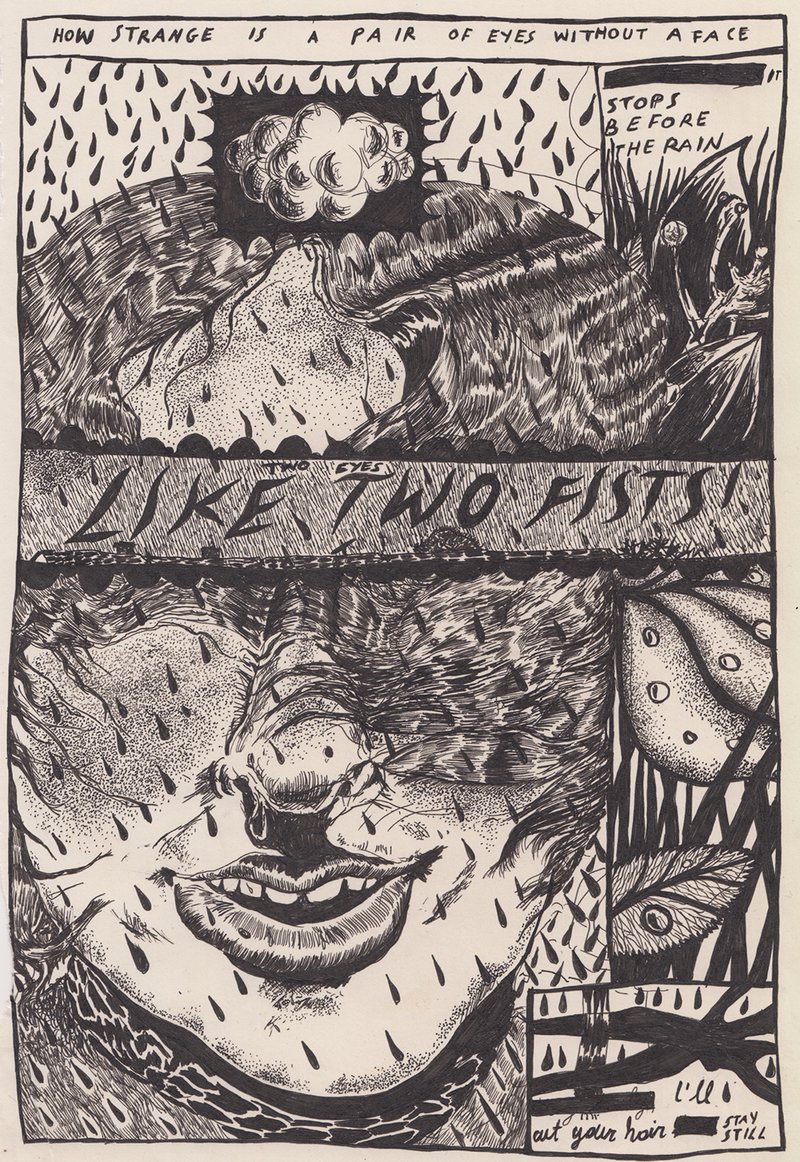
How strange is a pair of eyes (2020)
Gel ink on sketchbook paper 25 x 18 cm
A Swimming Pool For When We Run Out Of Water will be live from the 7th of May (5pm) until the 7th of July (5 pm). An archive of other work produced during the year can be found on the School’s website.
Follow Irene Montemurro @motenmruro
